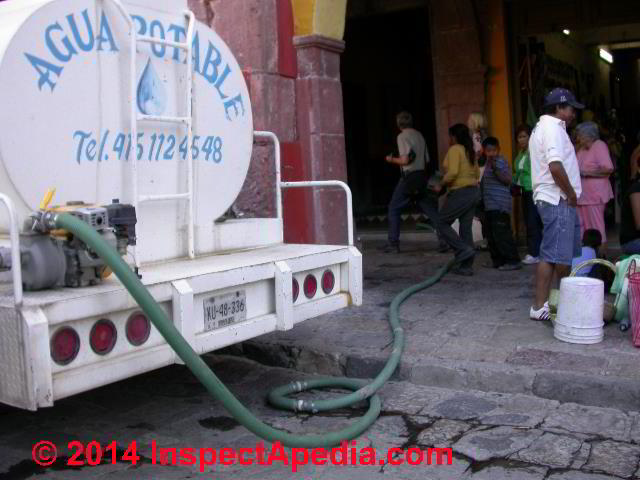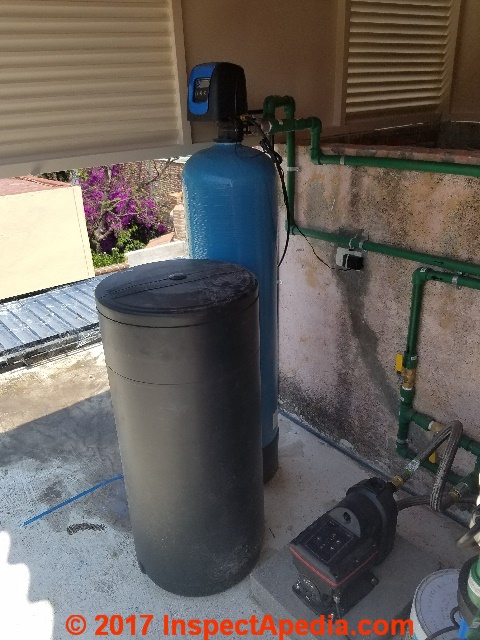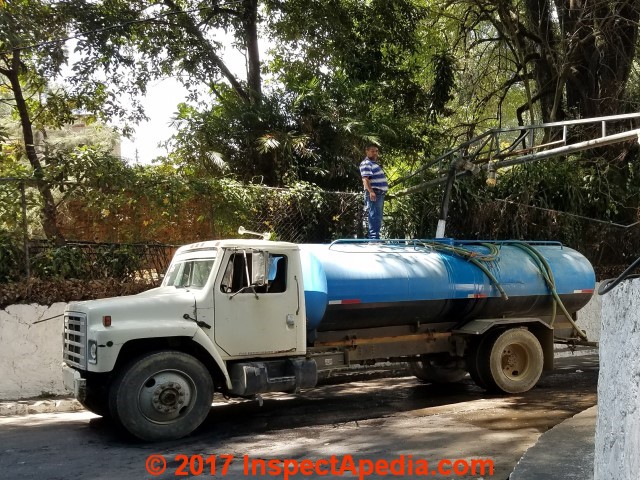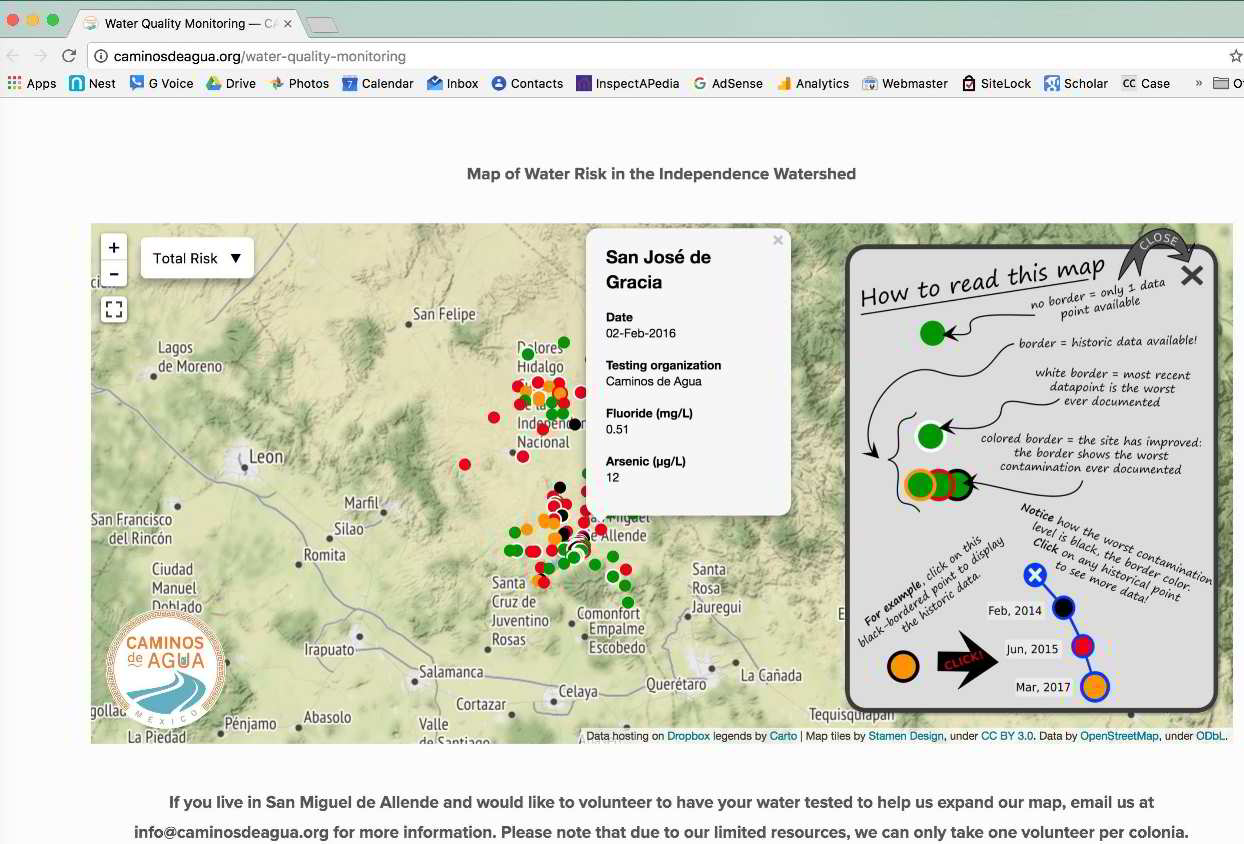 Drinking Water San Miguel de Allende
Drinking Water San Miguel de Allende
Water contaminants, sources, treatments & Water Quantity Limitations
- POST a QUESTION or COMMENT about potable drinking water in the San Miguel de Allende area
This article provides information & research describing the quantity and quality of drinking water in and around San Miguel de Allende in Guanajuato, Mexico.
Notice: this document is in DRAFT form for REVIEW purposes and will require corrections and additions as it is reviewed by water quality experts. Please use the page top or bottom CONTACT link to offer suggestions, research, or additional content.
This article series explains limitations on both water quantity and water quality available and describes conditions impacting the future quantity and quality of water available in the area of San Miguel de Allende, a city in central Mexico in the state of Guanajuato.
The combination of climate change, population increase, and increased water usage for agricultural or industrial uses imposes limitations that face state and local governments as well as private citizens.
This article series also explains the limitations of relying only on disinfection (chlorine or other disinfectants) to make drinking water safe and potable if / when inorganic contaminants such as arsenic, fluorides, or lead are present in water supplies of any community.
Our page top photo shows potable water being delivered by a pipa (water delivery truck) to a storage cistern in San Miguel de Allende, Guanajuato, Mexico. Many residents in Guanajuato rely on purchase of bottled water from Ciel or other purified water suppliers in the area.
InspectAPedia tolerates no conflicts of interest. We have no relationship with advertisers, products, or services discussed at this website.
- Daniel Friedman, Publisher/Editor/Author - See WHO ARE WE?
Drinking Water Quality in San Miguel de Allende, Mexico, Research, Monitoring, Test Results

Our photographs above and below show the installation of rooftop water treatment equipment on a home in San Miguel de Allende in Guanajuato, Mexico.
In a proper design the sequence of water treatment equipment is important. In the water treatment system shown here, water passes from the municipal supply piping up to a rooftop water storage tank and from the tank through a pressure booster pump, through a water softener, then through water filtration equipment, and then through a UV light disinfection system.
2019 Update: limited-scope private water quality studies in process in San Miguel de Allended, Guanajuato
- 03-26-2019 Periodic Screen for Arsenic in city water supply, periodic screening samples, Colonia San Antonio.
An arsenic test of the city water supply for San Miguel de Allende that we performed in March 2019 found between 5 and 10 ppb of arsenic.
The current WHO and US EPA MCL for arsenic in drinking water is 10 ppb.
See details at ARSENIC in DRINKING WATER TEST results in San Miguel de Allende - 03-26-2019 Screen purchased bottle water from local supplier, check arsenic, bacteria.
An arsenic test of a sample of bottled water from Ciel™ that we performed in March 2019 did not detect arsenic in that water supply. - 03-01-2019 Periodic Check of Water Hardness, city water supply, periodic screening test, Colonia San Antonio
A water hardness test performed on the city water supply for San Miguel de Allende (Col. San Antonino) found about 25 ppm or about 2 grains of total hardness per gallon.
Indeed typically San Miguel's water is at 27 ppm total hardness or about 2 grains or hardness per gallon of water.
See details at WATER HARDNESS TEST San Miguel de Allende
[Click to enlarge any image] The preparation of this Fleck water softener for use by filling the blue poly glass resin tank is described
at WATER SOFTENER RESIN REPLACEMENT.
As we mention below, one or more point of use reverse osmosis treatment systems may be used to remove inorganic contaminants not handled by the rooftop water treatment equipment.
The first photo shows a high capacity water softener (blue resin tank) along with its black brine tank (salt tank).
Water softeners are used to remove high levels of minerals, principally calcium and magnesium from the water supply, thus avoiding excessive scale formation (sarro) that blocks piping and clogs tankless water heaters as well as leaving hard-to-clean white deposits on plumbing fixtures. We illustrate the installation of this water softener
at WATER SOFTENER RESIN REPLACEMENT.
WATER SOFTENERS & CONDITIONERS - provides a complete guide to water softening equipment installation, use, maintenance.
Our second photo, given below, illustrates a typical pair of whole house water filters (those vertical blue cylinders).
Water passes first through a sediment filter and second through an activated charcoal filter.
More about these sediment and activated charcoal filters is
Above the two water filters in our second photograph you'll spot a horizontal stainless steel tube that contains a water disinfection system, a UV light.
 For a UV lamp to work it is essential that it is protected from clogging by sediment or mineral scale.
For a UV lamp to work it is essential that it is protected from clogging by sediment or mineral scale.
For this reason, the UV light is (almost) the last step in this series of water treatment equipment for the building.
At UV ULTRAVIOLET LIGHT WATER TREATMENT we explain that UV light disinfection systems can kill bacteria but not in all forms: certain cysts are very resistant to UV disinfection.
Out of the UV lamp water passes into the building for use at various plumbing fixtures.
Do not try following the green water supply piping in these photos as it will give you a headache. On the pipes for an installation like this one we mark directional arrows to help future users understand how the system is working.
In both photographs you'll notice a black Grundfoss SCALA2 pressure booster pump necessary to send water from the rooftop water storage tank through this water treatment equipment and onwards into the building they serve.
More about methods for boosting water pressure and the Grundfoss SCALA2 variable speed pump are
at WATER PRESSURE BOOSTER PUMP.
When all of this water treatment was installed and working in the building one of the installing plumbers commented
"Well now you can drink this water with no worries."
Really? Not necessarily.
Depending on where a building is located in the city, and depending on which of San Miguel de Allende's twenty water wells is supplying it, how the municipal water supply may be mixed from these source wells at different times of the year, how heavy might be the current water usage in the city, and seasonal as well as long term lowering of the water table, even a municipal water supply is at risk of encountering non-biological contaminants such as arsenic, mercury, or fluorides that would require additional steps to remove them from the water supply.
In addition to the equipment outlined above, one or more point of use (POU) reverse osmosis systems (RO) may be installed, such as at a kitchen sink, to remove inorganic contaminants that might sometimes be present in a water supply such as arsenic or fluorides. The RO system is not shown here.
Note: in 2019 we began private testing of San Miguel water for arsenic contamination and will report on those results with a link given here.
Details about reverse osmosis water treatment equipment are
at REVERSE OSMOSIS WATER TREATMENT.
Below we provide research and information sources that address water quality and potability questions for the greater area of San Miguel de Allende.
Watch out: most point of use water filters such as carbon filters and other "magic bullet" "water purifier filters" sold for use at a water tap or sold as pitchers that include a water filter are ineffective, unreliable, and may be downright dangerous for users as water contaminants vary over time even in a municipal water supply.
Yet we see such products widely used both in private homes and in some restaurants and other public facilities.
Even ceramic water filters, generally a broadly-effective water filter and one of our favorites, are limited in their ability to remove inorganic water contaminants.
Special thanks to Dylan Terrell, Executive Director of Caminos de Agua, for providing some of the technical resources given here.
Research & Water Quality Information Sources, San Miguel de Allende & Other Areas
 Water quality in Mexico is monitored by CONAGUA and is further monitored by the Secretary of Health. In addition local water quality monitoring is performed by the local water department providing water to the muncipality, such as SAPASMA. The reports of that monitoring are not easily obtained by the public, and many water supplies, both public and private, have to cope with contaminant levels that vary by season, usage, and geography.
Water quality in Mexico is monitored by CONAGUA and is further monitored by the Secretary of Health. In addition local water quality monitoring is performed by the local water department providing water to the muncipality, such as SAPASMA. The reports of that monitoring are not easily obtained by the public, and many water supplies, both public and private, have to cope with contaminant levels that vary by season, usage, and geography.
Water quantity and quality vary widely across Mexico, geographically, seasonally, and as a feature of increasing water usage, as it does in most other countries.
The Manantial Yerba Buena, in Uruapan, Mexico, provides voluminous potable water that here is shown being loaded into a pipa.
- Caminos de Agua, WATER QUALITY MONITORING [Web page], searchable map showing wells (pozos) in the greater area of San Miguel de Allende, Guanajuato,Mexico, retrieved 2017/04/21, original source: http://caminosdeagua.org/water-quality-monitoring/
Excerpt:
The searchable maps ... highlight the fluoride and arsenic levels throughout the region. Both Mexican and World Health Organization (WHO) maximum allowable concentrations (MAC) for fluoride are 1.5 mg/L. The Mexican MAC for arsenic is 25 µg/L (or 0.025 mg/L), and the WHO limit for arsenic is 10 µg/L. - CAMINOS de AGUA, [Website], Caminos de Agua, Dylan Terrell, Executive Director, Allende #5
Colonia Insurgents, San Miguel de Allende, Gto, México, & USA Chicago Office, 11 S. Green St. Unit 1508, Chicago, IL 60607-1033, USA, Email: info@caminosdeagua.org
T: +52-415-154-8091,
This association provides & assists in projects providing sustainable drinking water supplies including rainwater harvesting systems, ceramic water filters, biochar water treatment and other water supply, treatment and potability projects. - MAPS of Water Risk in the Independence Watershed around San Miguel de Allende, Guanajuato, Mexico, prepared and hostd at the Caminos de Agua website - see http://caminosdeagua.org/water-quality-monitoring[Web page]
Clicking on any dot on this map will yield recent water test results. For example clicking on San Jose de Gracia in the San Miguel de Allende area will show testing on 2 Feb 2016 by Caminos de Agua, as we illustrate with the page snapshot shown here.
[Click to enlarge any image]
- Chacon-Torres, A., L. G. Ross, M. C. M. Beveridge, and A. I. Watson. "The application of SPOT multispectral imagery for the assessment of water quality in Lake Patzcuaro, Mexico." International Journal of Remote Sensing 13, no. 4 (1992): 587-603.
- CONAGUA, Avenida Insurgentes Sur 2416, Copilco El Bajo, Ciudad de México. C.P. 04340 Teléfono: 51744000 Atención a la ciudadanía: 018002662482 Comisión Nacional del Agua Website: http://www.gob.mx/conagua Email: gobmx@funcionpublica.gob.mx
- Gallegos, E., A. Warren, E. Robles, E. Campoy, A. Calderon, Ma G. Sainz, Pa Bonilla, and O. Escolero. "The effects of wastewater irrigation on groundwater quality in Mexico." Water Science and Technology 40, no. 2 (1999): 45-52.
- Garcia y Garcia, Enrique, El Agua en san Miguel de Allende, ayer, hoy y manana, D.R. © PFT S.C., Camino al Ojo de Agua 15, Barrio Ojo de Agua, 37700 San Miguel de Allende, Gto, ptfsc@prodigy.net.mx (2006) ISBN 968-9193
- Gutierrez, Melida, and Patricia Borrego. "Water quality assessment of the rio Conchos, Chihuahua, Mexico." Environment International 25, no. 5 (1999): 573-583.
- Hernández-Romero, A. Héctor, Cristian Tovilla-Hernández, Edi A. Malo, and Ricardo Bello-Mendoza. "Water quality and presence of pesticides in a tropical coastal wetland in southern Mexico." Marine Pollution Bulletin 48, no. 11 (2004): 1130-1141.
- Juárez-Figueroa, Luis Alfredo, Jesús Silva-Sánchez, Felipe Javier Uribe-Salas, and Enrique Cifuentes-García. "Microbiological indicators of water quality in the Xochimilco canals, Mexico City." salud pública de méxico 45, no. 5 (2003): 389-395.
- Murdoch, Peter S., Jill S. Baron, and Timothy L. Miller. "Potential Effects Of Climate Change On Surface‐water Quality In North America" JAWRA Journal of the American Water Resources Association 36, no. 2 (2000): 347-366.
- Razo, Israel, Leticia Carrizales, Javier Castro, Fernando Díaz-Barriga, and Marcos Monroy. "Arsenic and heavy metal pollution of soil, water and sediments in a semi-arid climate mining area in Mexico." Water, Air, & Soil Pollution 152, no. 1 (2004): 129-152.
- "Reporte de Resultados de Calidad del Agua de Pozos de la Zona Urbana del 2013 realizados por un laboratorio acreditado ente la EMA (Entidad Meicana de Acreditacio)," SAPASMA Water Quality Report, San Miguel de Allende, on request of CONAGUA, public data from (2013) [PDF]
- Torres, Arturo Chacón. "Lake Patzcuaro, Mexico: watershed and water quality deterioration in a tropical high-altitude Latin American lake." Lake and Reservoir Management 8, no. 1 (1993): 37-47.
- WATER HARDNESS TEST San Miguel de Allende
- WATER QUALITY MONITORING DATASET [EXCERPTS] by Caminos de Agua[PDF] this data is EXCERPTED from the original Excel spreadsheet: in order to produce a printable, legible document we deleted some less-critical (to consumers) data columns in the original spreadsheet provided by Caminos de Agua and titled: Water Quality Monitoring Dataset by Caminos de Agua. The full dataset, cited next as an EXCEL spreadhseet is available at the Caminos de Agua website cited above and licensed under the Creative Commons Atribution 4.0 International License (C) 2017.
- Water Quality Monitoring Dataset by Caminos de Agua[Excel Spreadsheet], harder to read, described above.
Watch out: as this is an active Excel spreadsheet viewers should take care not to accidentially modify or corrupt their copy. - WELL WATER QUALITY IN SAN MIGUEL DE ALLENDE, Phase I: Results and Conclusions [PDF], Direccion de Medio Ambiente y Ecologia, Municipio de San Miguel de Allende, prepared by Ecosystems Sciences Foundation (2006) Ecosystem Sciences Foundation 280 N 8th St., Ste. 208, Boise, Idaho 83702 ecosystemsciences.com
Abstract:
Community wells in rural areas of the San Miguel de Allende Municipality were tested between September 2005 and February 2006 to determine contamination from arsenic, fluoride, and coliform bacteria. Other water quality parameters such as pH, hardness, and alkalinity were also tested.
Of the 101 water samples analyzed, 20 exceeded the Mexican government drinking water standard permissible limits for fluoride levels and 69 tested positive for coliform; no fecal coliform was detected.
The arsenic levels at all sites sampled were below the Mexican government drinking water standards and do not pose a health risk.
More than 100,000 people reside in the rural areas where testing was conducted and they all depend upon groundwater for their drinking water. As the groundwater supply in this region diminishes due to overuse, the contaminant concentrations increase, putting users at greater risk of suffering health effects.
Adverse health effects as a result of exposure to excessive fluoride concentrations and coliform bacteria are well documented.
This study employed water quality testing and GIS analysis to identify rural communities at greatest risk of exposure to contaminants so that treatment strategies can be prioritized and implemented to reduce that risk.
Treatment options include providing education and training in identifying contamination sources (for coliform), providing trucked water, and implementing rain water harvesting systems in areas with the highest fluoride concentrations. These strategies will be employed during subsequent phases of the project.
Water Quality & Water Quantity Research: San Miguel de Allende, Guanajuato, Mexico
As we discuss separately at WATER DISINFECTION LIMITATIONS, there is growing evidence that drinking water disinfection alone can be ineffective in adequately removing drinking water contaminants, both because of procedural errors and possibly because of persistent contaminant sources or contaminants that are partly-encapsulated inside water piping or containers, requiring extra contact time or additional cleaning and disinfection methods to assure a stable sanitary drinking water supply.
Examples of Water Disinfection Limitations
Watch out: as we report throughout this article series, different disinfection methods vary in their effectiveness in combating different types of water contaminants. If you rely on a single disinfection method, for example chlorine disinfection, your water supply could still be contaminated by cryptosporidium, or if chemical contaminants are present, those, too, might remain.
Municipal water supplies are generally safe as their water treatment efficacy is monitored regularly as required by federal regulations. But private water supplies may be at risk.
Consulting with your local health department and local water testing laboratories can provide locally-accurate advice on what water tests are most important to perform in order to understand what water treatment may be necessary for your home or building.
...
Continue reading at WATER DISINFECTION LIMITATIONS or select a topic from the closely-related articles below, or see the complete ARTICLE INDEX.
Or see these
Recommended Articles
- AIR QUALITY STUDY San Miguel de Allende
- ARSENIC in DRINKING WATER TEST results in San Miguel de Allende
- CISTERNS, WATER STORAGE
- REVERSE OSMOSIS WATER TREATMENT - capable of removing arsenic, fluorides, lead, other contaminants, but also consuming water in the process
- WATER FILTERS, HOME USE
- WATER HARDNESS TEST San Miguel de Allende
- WATER PUMP VARIABLE FREQUENCY / VARIABLE SPEED DRIVE (VFDs)
- WATER SOFTENERS & CONDITIONERS for treatment of water high in mineral content
- WATER TANK CLEANING CODES STANDARDS
- WATER TREATMENT EQUIPMENT CHOICES
Suggested citation for this web page
WATER QUALITY & QUANTITY San Miguel de Allende at InspectApedia.com - online encyclopedia of building & environmental inspection, testing, diagnosis, repair, & problem prevention advice.
Or see this
INDEX to RELATED ARTICLES: ARTICLE INDEX to WATER TREATMENT SYSTEMS
Or use the SEARCH BOX found below to Ask a Question or Search InspectApedia
Ask a Question or Search InspectApedia
Try the search box just below, or if you prefer, post a question or comment in the Comments box below and we will respond promptly.
Search the InspectApedia website
Note: appearance of your Comment below may be delayed: if your comment contains an image, photograph, web link, or text that looks to the software as if it might be a web link, your posting will appear after it has been approved by a moderator. Apologies for the delay.
Only one image can be added per comment but you can post as many comments, and therefore images, as you like.
You will not receive a notification when a response to your question has been posted.
Please bookmark this page to make it easy for you to check back for our response.
IF above you see "Comment Form is loading comments..." then COMMENT BOX - countable.ca / bawkbox.com IS NOT WORKING.
In any case you are welcome to send an email directly to us at InspectApedia.com at editor@inspectApedia.com
We'll reply to you directly. Please help us help you by noting, in your email, the URL of the InspectApedia page where you wanted to comment.
Citations & References
In addition to any citations in the article above, a full list is available on request.
- Arnold, Benjamin F., and John M. Colford Jr. "Treating water with chlorine at point-of-use to improve water quality and reduce child diarrhea in developing countries: a systematic review and meta-analysis." American journal of tropical medicine and hygiene 76, no. 2 (2007): 354-364.
- Schoenen, D. "Role of disinfection in suppressing the spread of pathogens with drinking water: possibilities and limitations." Water research 36, no. 15 (2002): 3874-3888.
- "Bacteria in Drinking Water" - "Chlorine," Karen Mancl, water quality specialist, Agricultural Engineering, Ohio State University Extension. Mancl explains factors affecting the effectiveness of chlorine in water as a means to destroy bacteria and other microorganisms. OSU reports as follows:
Chlorine kills bacteria, including disease-causing organisms and the nuisance organism, iron bacteria. However, low levels of chlorine, normally used to disinfect water, are not an effective treatment for giardia cysts. A chlorine level of over 10 mg/1 must be maintained for at least 30 minutes to kill giardia cysts. -- http://ohioline.osu.edu/b795/index.html is the front page of this bulletin.
- www.epa.gov/ogwdw/mdbp/pdf/alter/chapt_2.pdf provides an article on use of disinfectants for water treatment
- Extreme Lead Poisoning Symptoms Suggested by Feb 2006 NY Times Article on Kosovo Roma Camps
- Handbook of Disinfectants and Antiseptics, Joseph M. Ascenzi (Editor), CRC, 1995, ISBN-10: 0824795245 ISBN-13: 978-0824795245 "The evaluation of chemical germicides predates the golden age of microbiology..." - medical uses of antiseptics and disinfectants
- Principles and Practice of Disinfection, Preservation and Sterilization (Hardcover)
by A. D. Russell (Editor), W. B. Hugo (Editor), G. A. J. Ayliffe (Editor), Blackwell Science, 2004. ISBN-10: 1405101997, ISBN-13: 978-1405101998. - U.S. Army Field Manual 21-10, Field Hygiene and Sanitation [PDF] 1988, web search 07/02/2010, original source: http://www.enlisted.info/field-manuals/fm-21-10-field-hygiene-and-sanitation.shtml
The purpose of this manual is to assist individual soldiers, unit commanders, leaders and field sanitation teams in preventing disease and environmental injuries.
The manual provides information on preventive medicine measures (PMM) to the individual soldier as well as essential information for the unit commander, unit leaders, and the unit field sanitation team on applying unit level PMM. - When Technology Fails, Matthew Stein, Chelsea Green Publisher, 2008,493 pages. ISBN-10: 1933392452 ISBN-13: 978-1933392455, "... how to find and sterilize water in the face of utility failure, as well as practical information for dealing with water-quality issues even when the public tap water is still flowing". Mr. Stein's website is www.whentechfails.com/
- In addition to citations & references found in this article, see the research citations given at the end of the related articles found at our suggested
CONTINUE READING or RECOMMENDED ARTICLES.
- Carson, Dunlop & Associates Ltd., 120 Carlton Street Suite 407, Toronto ON M5A 4K2. Tel: (416) 964-9415 1-800-268-7070 Email: info@carsondunlop.com. Alan Carson is a past president of ASHI, the American Society of Home Inspectors.
Thanks to Alan Carson and Bob Dunlop, for permission for InspectAPedia to use text excerpts from The HOME REFERENCE BOOK - the Encyclopedia of Homes and to use illustrations from The ILLUSTRATED HOME .
Carson Dunlop Associates provides extensive home inspection education and report writing material. In gratitude we provide links to tsome Carson Dunlop Associates products and services.


